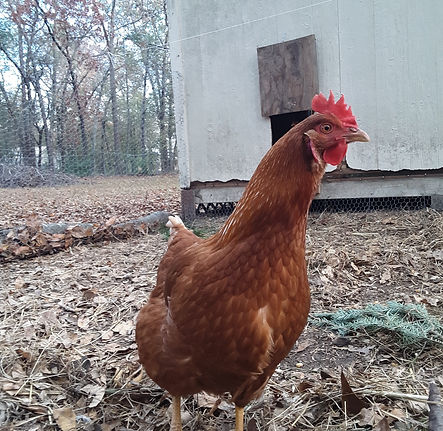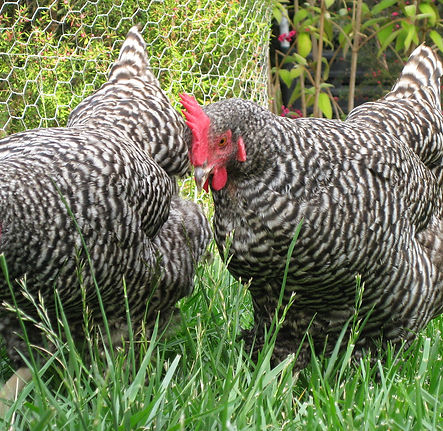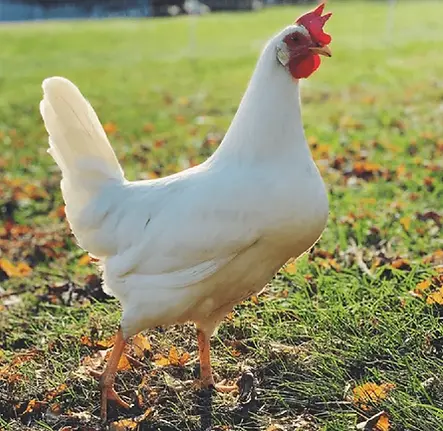
Cole Family Farm
Cole's Organic Eggs

Finding the Breed for You
This is a general overview of chicken breeds to decide what breed may best fit your needs


Meet the chickens

Rhode Island Red
Rhode Island Red chickens are medium to large, dual-purpose birds with reddish-brown feathers, red combs, and yellow feet. They are known for being hardy and adaptable to a variety of climates. [1, 2, 3, 4, 5] Appearance [1, 2, 6] • Color: Deep red to almost black feathers, with a mostly black tail • Comb: Single or rose-comb, and vivid red • Eyes: Reddish bay • Beak: Reddish horn color • Feet and legs: Yellow, often with some red on the toes and sides of the shanks • Body: Rectangular, with broad chests and a straight back Size [2] • Hens: Weigh about 6.5 pounds • Roosters: Weigh about 8.5 pounds Temperament [6, 7] • Friendly with people, but can be aggressive, especially when kept in small spaces • Can be fairly dominant in a flock Egg production [8] • Lay eggs even during the winter months [8] • While they don't lay as many eggs during the winter, they can easily withstand the cold [9] Adaptability [5] • Well known to be adaptable to both warm and cold climates • Can survive in just about any environment and even in minimal care situations

ISA Brown
ISA Brown chickens are known for being docile, friendly, and affectionate. They are a good choice for families with children and are often recommended for beginners. [1, 2, 3] Temperament [1, 2] • Calm, docile, and non-aggressive • Enjoy interacting with humans and may be held or cuddled • Don't make too much noise Egg production [4, 5] • Lay lots of eggs, including 6+ large light brown eggs a week • In their first year, they can produce up to 300 eggs • Egg production decreases by 10 to 15% per year as chickens age Maintenance require relatively low maintenance, can cope well with confinement, and love to forage. [3] Size [3, 6] • Moderate in size (2-3kg) • Compact, robust body • Typically weigh around 4-6 pounds Other considerations [2] • If you mix ISA Browns in with other breeds, they may get pecked, bullied, or attacked by more confident breeds [2] • It is recommended not to breed these chickens [3]

Plymouth Rock
Plymouth Rock chickens are docile, easy to manage, and good with children. They are known for their red earlobes and brown eggs. [1, 2, 3] Appearance [1, 2] • Color: Plymouth Rocks come in many colors, including white, barred, buff, and silver penciled [1, 2] • Feathers: Plymouth Rocks have thick feathers with a barred pattern of light and dark bars [2, 3, 4] • Head: Plymouth Rocks have red combs, wattles, and earlobes, and bay-colored eyes [2, 5] • Body: Plymouth Rocks have long, broad backs and moderately deep breasts [5] • Legs: Plymouth Rocks have yellow, unfeathered legs [2, 5] • Beak: Plymouth Rocks have yellow or horn-colored beaks [2, 5] Temperament [1, 3] • Plymouth Rocks are docile and friendly • They are good with children and make good family pets • They are easy to keep in flocks and get along with other breeds Egg production [6] • Plymouth Rock hens start laying eggs at 16–22 weeks old • They lay consistently throughout the year, even in cold weather • They lay best for the first few years and start declining egg production around 3 years old Uses [1, 7] • Plymouth Rocks are dual-purpose birds, used for both eggs and meat

Buff Orpington
Buff Orpington chickens are known for being gentle, docile, and friendly. They are a good choice for families and small farms. [1] Appearance [2, 3] • Body: Broad, deep, and well-rounded with a short neck • Plumage: Fluffy, soft, and smooth with a golden color • Head: Single, medium-sized, bright red comb with five points, bright red wattles, and bright red earlobes • Legs: Bare • Tail: Short Temperament [1, 4] • Calm, gentle, and non-aggressive • Respond well to attention • Get along well with other chicken breeds Egg production [5] • Hens start laying eggs at around three to six months • Lay between 200-280 light brown eggs a year, ranging from large to extra-large Other characteristics [4, 6] • Active fowl that does well free-range or confined • Quiet • Have a deep breast with a curved back • Short legs with thighs covered by thick feathering Family-friendliness [4] • Buff Orpingtons have a reputation as the friendliest variety, making them a great family-friendly chicken breed

Astralorp
Australorp chickens are medium to large, calm, and known for their excellent egg-laying abilities. They have close-fitting feathers, dark eyes, and black beaks. [1, 2] Appearance [1, 3, 4] • Color: Black, white, or blue • Feathers: Close-fitting, soft, and fluffy • Legs: Slate blue or black, with pinkish-white feet and toes • Eyes: Dark brown • Beak: Black • Comb and wattles: Red, with roosters having larger, brighter combs than hens Size [3] • Standard Australorps weigh 3–4 kg • Bantam Australorps weigh 0.7–1.2 kg • Roosters are typically larger and heavier than hens Temperament [5] • Initially timid and shy, but quickly warm to humans • Have a genial and compassionate demeanor Other characteristics [4, 5] • Cold hardy and moderately heat tolerant • Enjoy foraging freely to supplement their diet • Have a lifespan of 6–10 years Egg-laying [2, 6] • One of the best dual-purpose fowls • A top choice for both beginner and experienced chicken owners

Leghorn
Leghorn chickens are known for being active, independent, and good egg layers. They can be raised for eggs, meat, or as pets. [1, 2, 3] Characteristics [4] • Flight: Leghorns are strong fliers and may roost in trees. [4] • Temperament: Leghorns are friendly and curious, but they are not docile or affectionate. [1] • Noise: Leghorns are noisy and talkative. [1] • Space: Leghorns need plenty of space to explore and roam. [1, 5] • Egg production: Leghorns are known for their high rate of egg production. [5] • Foraging: Leghorns are good foragers and can adapt to almost any type of soil. [2, 5] • Heat tolerance: Leghorns are heat tolerant and have large wattles and floppy combs to help cool down. [6] Other traits [4] • Leghorns have red wattles, white earlobes, and either a single or rose comb. [4] • Leghorns are hardy and can adapt to their environment. [2] • Leghorns are not known for being a disease resistant or a particularly cold hardy breed. [6] • Leghorns are not ideal for quiet, urban flocks. [1] Leghorns come in many colors, including white, brown, buff, black, silver, and red. [7]

Hopefully you find one that meets your needs


Hoover's is the place I always order my chickens and I've ALWAYS been satisfied.


